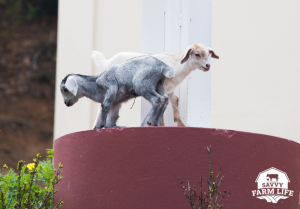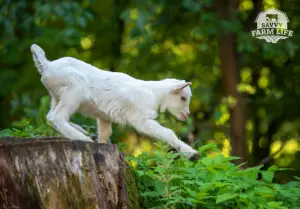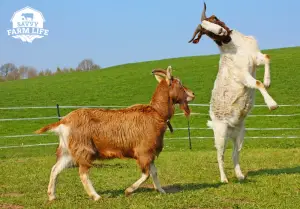What Goats Like To Play With
Just like any other animals, goats can get bored. They need a certain amount of mental and physical stimulation in their lives to keep things interesting. Boredom can lead to injuries and property damage as a result of the search for something interesting to do. You can keep your goats both safe and happy by adding some fun to their enclosure.
So, what do goats like to play with? Goats like to play with other goats as well as things they can climb on and toys that drop treats when kicked around. Goat toys can be purchased, or they can be made yourself. These kinds of additions to your goats’ environment, called “enrichment,” are the same kinds of things zoos are required to provide for their animals.
There are countless scientific studies to support the tremendous benefit that enrichment provides to all captive animals that have access to it. That being said, read on to learn more about what goats like to play with.
How To Provide The Best Environment For Goats To Play
Meet Their Social Needs 
The easiest way to do this is to purchase multiple goats in the beginning. If you already have a single goat and want to acquire a couple of friends for it, be sure to follow safe introduction procedures. Keep new goats separate for a few days to watch for any health issues and allow them to adjust to the new smells and sounds. Give new goats a chance to explore the environment alone so they can learn where the food and water sources are without competition.
Then introduce the original goat to the new ones under supervision. Let them check each other out and maybe display a few dominance behaviors as they figure out the new pecking order. A little scuffling is normal.
In the case of a herd with some animals being bullied, it’s a good idea to have visual barriers throughout the enclosure around which bullied goats can hang out to avoid death glares from the bully. Even without the need to provide space from bullies, visual barriers are great for making the enclosure feel bigger and more interesting.
Meet Their Habitat Needs
To meet both the visual barrier needs and the instinct to climb up everything available, goat jungle gyms can be purchased or built yourself from plywood and two-by-fours. Steps, ramps, and platforms can easily be assembled and placed in your goats’ enclosure to provide climbing opportunities and visual barriers. The physical barrier also serves to make the enclosure feel bigger and more complex.
Tree stumps and logs can also be placed throughout the enclosure and combined in various ways to create more enriching habitat features. These items can be moved around from time to time to change things up. Or, if the enclosure is large enough, it can be sectioned off so that goats only get access to certain areas at any given time. That rotating schedule would be another excellent form of enrichment.
Keep in mind that some goats will eat things they shouldn’t. So make sure to avoid leaving any dropped nails or other hardware in or near their enclosure.
Additional things that can be added enrichment for goats are overturned old canoes, seesaws, kiddie pools, plastic or wood playhouses, old dog houses, tires, boulders, and barrels.
Meet Their Foraging Needs 
There is an infinite number of ways to enhance foraging opportunities for your goats. From hiding treats around the enclosure to stuffing foraging toys with goodies, it can be done easily and inexpensively.
Perhaps the easiest method of foraging is hiding treats such as fruits and veggies throughout the enclosure. Place a piece of carrot on top of a platform, wedge an apple slice between some tree bark on a stump, or stick a few berries on the fence wire. Sprinkling these goodies throughout a hay pale or tossing them over the ground will also do the trick.
Goats will be more excited to explore their environment when they know there are some rewards to be had for it.
As for foraging toys, there are several commercially available and also lots of ways to DIY them. As for commercially available options, most foraging toys for cats and dogs will also work for goats. Puzzle food bowls, treat balls with little holes that drop treats as they roll, and even large kongs are all great options for making your goats work harder for treats or even regular food.
The easiest toy to make yourself is something along the lines of the treat ball. You can use a hard plastic ball or a piece of PVC pipe. Drill holes just big enough for food to drop through, then add food. For the pipe, cap one end, add treats, then cap the other end. Either leave this in the enclosure for your goats to figure out, or shake it a little in front of them to show them that treats will come from it.
For further enrichment and fun for your goats, rotate which goat toys are available every few days so that there is always something new to investigate. With so much mental and physical stimulation opportunities in their enclosure, your goats will live happier and healthier lives.
What Do Goats Need To Be Happy and Have Fun?
Goats are social animals who require the presence of a herd to be a part of for socialization and protection. Goats are also intelligent animals who were made for toughing it out in rough terrain and spending most of their time climbing around and foraging for food. When captive goats are penned up in a dull enclosure with plenty of food easily available, they’re in danger of getting bored and getting into all kinds of trouble as a result.
Social Requirements for Goats
Because goats are herd animals, they have an innate need to be with other goats at all times. Being separated from the flock is distressing. Goats should never be kept alone, except for extreme medical circumstances. Even then, if possible, keep a healing goat in it’s own pen near its herd so that it can still see and hear its friends even if it can’t be right there with them.
Even when goats are kept as pets in the house, it is best to make sure there are at least two so that no one gets lonely. There will be times when you must leave the house and being alone will make your goat anxious because of that innate need to stick to the group.
Habitat Requirements for Goats 
As much as goats should have access to a flock, sometimes some other flock members can be a little overbearing. It can be helpful to have multiple feeding stations with visual barriers between them, especially if you notice that one of your goats is getting bullied by the others. Bullied goats will feel more comfortable eating in a place where the bullies can’t see them.
One great way to provide visual barriers is with items that double as climbing objects. In the wild, goats do a lot of climbing. Their food sources are often difficult to reach and they usually come from areas with rougher terrain, so they naturally feel an inclination to climb up whatever they can. Being so high up also comes with the advantage of being out of reach of predators.
Speaking of predators, goats are really good at sensing the presence of carnivorous animals who mean them harm. Even if predators can’t get into their pen, the frequent presence of dangerous animals nearby can cause stress. It’s best to watch for signs of predators and do everything you can to prevent them from coming around even if the goat pen is safe.
When it comes to the size of the pen, goats need about 25 square feet of space each. This is for space to move around as well as foragable surface area. They’ll also need a rain-proof shelter to keep them dry during bad weather.
Foraging Requirements for Goats
Scientists have performed many studies on various animal species to learn more about their natural foraging behaviors. One experiment in particular provided rats with multiple different feeding stations with different levels of effort required to get to the food. In one area, the food was on the ground. In another, it was in a hopper overhead. And in another, a challenge had to be overcome to get to the food.
Most rats preferred expending extra effort to overcome the challenge and earn the food rather than simply eating the free food that was more easily accessible. Even though the same food was used in each space. Similar studies have been done in birds and other animals and had the same results. In general, animals would rather tackle the mental and/or physical stimulation of a challenge than simply eat food that costs no effort to acquire. Goats are the same.
Significantly more intelligent than we give them credit for, they appreciate a little challenge when foraging, at least some of the time. Getting creative with their food items can be fun for you while also increasing their physical fitness and preventing boredom by providing mental stimulation.
It’s a ton of fun watching goats have fun, so we hope that the info in this article has been helpful for you. To learn more about how to care for goats, you can check out my articles below.
P.S. Save this article to your “Goat” board on Pinterest!

